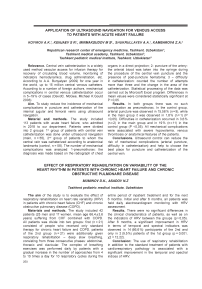Application of ultrasound navigation for venous access to patients with acute heart failure
Автор: Koyirov A.K., Kenjaev S.R., Mirmaksudov M.S., Shukrullayev A.A., Kambarova Z.A.
Журнал: Евразийский кардиологический журнал @eurasian-cardiology-journal
Рубрика: Хроническая сердечная недостаточность
Статья в выпуске: S2, 2019 года.
Бесплатный доступ
Central vein catheterization is a widely used method vascular access for infusion therapy for recovery of circulating blood volume, monitoring of indicators hemodynamics, drug administration, etc. According to A.A. Bunyatyan (2009) for one year in the world, up to 15 million central venous catheters. According to a number of foreign authors, mechanical complications in central venous catheterization occur in 5-19 %o of cases (DavidC. McGee, Michael K.Gould 2003) Aim. To study reduce the incidence of mechanical complications in puncture and catheterization of the internal jugular and femoral veins using ultrasound navigation.
Короткий адрес: https://sciup.org/143170254
IDR: 143170254
Текст статьи Application of ultrasound navigation for venous access to patients with acute heart failure
Material and methods. The study included 113 patients with acute heart failure, who admitted in 2018 to our department. Patients were divided into 2 groups: 1st group of patients with central vein catheterization was done under ultrasound navigation (main, n = 55), 2nd group of patients to whom the central vein was catheterized according to anatomical landmarks (control, n = 58). The number of mechanical complications was analyzed: 1-pneumothorax: the diagnosis was made based on the radiograph of chest organs in a direct projection; 2- puncture of the artery: the arterial blood was taken into the syringe during the procedure of the central vein puncture and the presence of post-puncture hematoma; 3 – difficulty in catheterization: counted the number of attempts more than three and the change in the area of the catheterization. Statistical processing of the data was carried out by Microsoft Excel program. Differences in mean values were considered statistically significant at P < 0,05.
Results. In both groups there was no such complication as pneumothorax. In the control group, arterial puncture was observed in 15,58 % (n = 9), while in the main group it was observed in 1,8 % (n = 1) (P <0,05). Difficulties in catheterization occurred in 3,6 % (n = 2) in the main group and in 19 % (n = 11) in the control group (P <0,05). All mechanical complications were associated with severe hypovolemia, venous thrombosis or anatomical features of the patients.
Conclusions. Ultrasound control can reduce the risk of mechanical complications (arterial puncture, difficulty in catheterization) and help to choose the best place for puncture and catheterization of the central vein.
EFFECT OF RESPIRATORY REHABILITATION ON VARIABILITY OF THE HEART RHYTHM IN PATIENTS WITH CHRONIC HEART FAILURE AND CHRONIC OBSTRUCTIVE PULMONARE DISEASE
MUMINOV D.K., ASADOV N.Z
Tashkent pediatric medical institute. Uzbekistan
The aim of the study is to evaluate the effect of respiratory rehabilitation on heart rate variability (HRV) in patients with chronic heart failure (CHF) and chronic obstructive pulmonary disease (COPD).
Materials and methods. The study included 42 patients (25 men and 17 women, mean age 66,4 ± 3,6 years) suffering from CHF combined with COPD. All patients was divide into two groups: first (n = 21) consisted of people who received only standard therapy for chronic heart failure and COPD, patients of the 2nd group (n = 21) were additionally given respiratory rehabilitation – deep slow breathing, consisting from three consecutive phases: abdominal, thoracic and clavicular. The complex of breathing exercises was performed daily by patients with a gradual increase in the number of approaches from 4 to 10 times a day for 10 respiratory cycles during the entire period of inpatient treatment and for the next 6 months. Initial and after 6 months, all patients was held daily electrocardiogram monitoring with HRV assessment.
Results. There were no significant differences in the clinical characteristics of patients, as well as on the indicators of HRV between the groups (p > 0,05). After 6 months, a significant improvement in HRV in terms of temporal and spectral indicators was observed in 14 (66,6 %) participants of the 2nd and only in 2 (9,5 %) patients of the 1st group (p = 0,001, χ2 = 12,22).
Conclusion: The use of respiratory rehabilitation in addition to the standard treatment of patients with cardiorespiratory pathology is associated with a significant improvement in the temporal and spectral indices of HRV.


